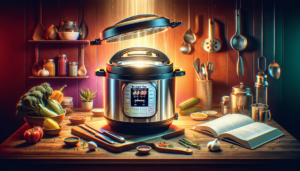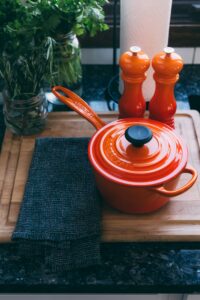How Do I Check The Food Inside While it is Cooking: Introduction
Imagine being able to conveniently monitor the progress of your cooking without constantly interrupting the process. We all know the struggle of trying to peek inside a hot oven or lift the lid off a steaming pot, only to be met with a burst of heat or steam. So, “How do I check the food inside while it is cooking?” is a question that crops up often.
Fear not, because there are a few ingenious methods to easily keep an eye on your food as it cooks, ensuring that it reaches perfection without any guesswork. Let us enlighten you with some clever techniques that will revolutionize the way you check on your food while it’s cooking.
Methods for Checking Food While Cooking
When it comes to ensuring that our food is perfectly cooked, there are several reliable methods we can employ. By using a combination of these techniques, we can have confidence that our meals will turn out delicious every time.
Using a Meat Thermometer
One of the most accurate ways to determine whether our meat is properly cooked is by using a meat thermometer. This handy tool allows us to measure the internal temperature of the meat, ensuring it reaches a safe level to kill any harmful bacteria.
To use a meat thermometer, simply insert the probe into the thickest part of the meat, making sure to avoid any bones. Wait for a few seconds until the temperature reading stabilizes, and then compare it to the recommended internal temperature for the specific type of meat. This method is especially useful for larger cuts of meat, such as roasts or whole chickens.
Performing a Visual Inspection
Sometimes, a visual inspection can provide valuable information about the cooking progress of our food. By looking at the color and texture, we can get a sense of whether it is cooked to our desired level of doneness.
For example, when grilling a steak, we can determine its doneness by observing the color of the meat. A rare steak will have a bright red center, while a medium steak will have a pink center and a medium-well or well-done steak will have little to no pink left. Additionally, the meat should feel firm but still have a slight give when pressed with tongs or a spatula.
Using a Timer
A simple yet effective method for checking food while cooking is by using a timer. Whether it’s a dedicated kitchen timer or the timer feature on our stove or oven, setting a reminder allows us to keep track of the cooking time and avoid overcooking or undercooking our food.
Timers are particularly useful when following a recipe that specifies a precise cooking time. They help us stay organized and ensure that we don’t get distracted or forget about our cooking.
Lifting the Lid
When cooking dishes that are prepared in a covered pot or pan, such as stews or braises, lifting the lid occasionally can provide insight into the cooking progress. By lifting the lid, we can observe the steam, check the tenderness of the ingredients, and adjust the heat if necessary.
It’s important to note that lifting the lid too frequently can prolong the cooking time and let valuable heat escape, so it’s best to limit this method to quick peeks every now and then.
Tasting a Sample
For those who are comfortable with tasting their food during the cooking process, sampling a small piece can help determine if it’s ready to be served. This method is especially useful for dishes like soups, sauces, and stir-fries, where the flavors develop and mix throughout the cooking time.
By tasting a sample, we can assess the seasoning, the texture, and the overall taste of our dish. However, it’s important to use a clean utensil each time we taste to avoid cross-contamination.
Checking with a Fork or Skewer
Piercing our food with a fork or skewer and observing the juices that come out can be a useful method for checking food while cooking. This technique is typically used for meat, poultry, or fish.
If the juices that come out of the punctured area are clear, it indicates that the food is properly cooked. However, if the juices appear pink or red, it may need further cooking. While this method can give us a rough idea of doneness, it’s important to remember that using a meat thermometer is the most accurate way to ensure food safety.
Monitoring the Cooking Progress
For dishes that require longer cooking times, it’s essential to regularly check on the cooking progress. This can be done by observing the bubbling of liquids, the color of the ingredients, and the overall consistency of the dish.
For example, when making a homemade tomato sauce, we can monitor the reduction of the liquid and the thickening of the sauce. By keeping an eye on these visual cues, we can ensure that our sauce reaches the desired consistency without burning or sticking to the bottom of the pot.
Using a Kitchen Timer App
In this digital age, there are numerous kitchen timer apps available for smartphones and tablets. These apps offer a convenient way to set multiple timers, customize alerts, and keep track of multiple dishes simultaneously.
Kitchen timer apps can be particularly helpful when juggling multiple tasks in the kitchen or when experimenting with complex recipes that require precise timing. They free us from having to carry around a physical timer and allow us to focus on other aspects of our cooking.
Checking the Internal Temperature
Similar to using a meat thermometer, checking the internal temperature of our food is crucial for ensuring it is cooked safely and to our desired level of doneness. This method is especially important for foods that require specific internal temperatures to guarantee they are fully cooked and safe to consume.
Different types of foods have different safe internal temperatures, so it’s important to consult reliable sources or recipe guidelines for the specific food we are cooking. By using an instant-read thermometer, we can quickly and accurately check the temperature, giving us peace of mind that our food is cooked to perfection.
Using an Oven Light
When cooking in an oven, especially when baking delicate dishes like cakes or soufflés, using the oven light can be a helpful method for checking the food’s progress without opening the oven door.
By turning on the oven light, we can observe the browning and rising of our baked goods, ensuring they are baking evenly and not becoming overly browned or burnt. This method allows us to closely monitor the cooking process without introducing temperature fluctuations caused by opening and closing the oven door.
Factors to Consider When Checking Food While Cooking
While the aforementioned methods are effective for checking food while cooking, there are several factors we should consider to ensure optimal results.
Type of Food Being Cooked
Different types of food require different methods of checking for doneness. For example, meat and poultry benefit greatly from using a meat thermometer, while visual cues and fork or skewer tests work well for grilled vegetables or seafood.
Understanding the characteristics of the specific food we are cooking allows us to choose the most appropriate method for checking its progress. By considering factors such as moisture content, density, and cooking time, we can adapt our checking method accordingly.
Cooking Method
The cooking method we choose also plays a significant role in determining how we should check our food while it’s cooking. Grilling, baking, sautéing, and steaming all require different approaches when it comes to monitoring the cooking progress.
For instance, when grilling, visual inspection and fork or skewer tests are often used to determine doneness. On the other hand, when baking, using a timer and an oven light may be more effective in monitoring the progress.
Cooking Time and Temperature
The recommended cooking time and temperature indicated in a recipe or a reliable source should guide our checking methods. Certain foods, such as poultry and ground meats, require higher internal temperatures to ensure safety, while others may require lower temperatures to maintain desirable textures.
It’s important to note that cooking times and temperatures can vary depending on the size and thickness of the food being cooked. Adhering to the specific cooking guidelines for each dish will help us achieve the best results.
Recipe Guidelines
Unless we are culinary experts, it’s always a good idea to consult recipe guidelines when checking our food while cooking. Recipes typically outline the cooking times, temperatures, and checking methods that have been tested and proven to yield delicious results.
Following recipe guidelines not only ensures that we cook our food properly, but it also gives us the opportunity to learn from experienced cooks and explore new techniques. Plus, who doesn’t love trying out a new recipe and enjoying a well-cooked meal at the end?

Equipment and Tools for Checking Food While Cooking
To effectively check our food while it’s cooking, having the right equipment and tools is essential. Here are some key items that can aid in the checking process:
Meat Thermometer
Investing in a reliable meat thermometer is a game-changer when it comes to cooking meat and poultry. It allows us to accurately measure the internal temperature of the food and ensure that it is safely cooked.
Look for a meat thermometer that is easy to use, has a clear digital display, and provides quick and accurate temperature readings. With a meat thermometer in hand, we can say goodbye to guesswork and confidently serve perfectly cooked meats to our family and friends.
Kitchen Timer
A kitchen timer is a must-have tool for any home cook. Whether it’s a simple digital timer or an app on our smartphone, having a reliable timer ensures that we never lose track of our cooking time.
Look for a timer that can be easily set, has audible alerts, and offers multiple timer functions. This handy tool will keep us organized in the kitchen and help us avoid overcooking or undercooking our dishes.
Oven Light
If our oven is equipped with an oven light, taking advantage of this feature can be incredibly useful. By turning on the oven light, we can easily monitor the progress of our baking without disturbing the cooking environment.
An oven light allows us to observe the rising and browning of our baked goods, ensuring they are cooking evenly and to our desired level of doneness. This tool is particularly valuable for delicate baked creations that require precision and careful monitoring.
Fork or Skewer
A simple tool like a fork or skewer can be surprisingly handy when it comes to checking the doneness of certain foods. By piercing through meat, vegetables, or seafood and observing the juices that come out, we can get a sense of how cooked they are.
Choose a high-quality fork or skewer that is sturdy and easy to clean. This versatile tool can be used in various cooking methods, from grilling to roasting to sautéing, helping us ensure that our food is cooked to perfection.
How Do I Check The Food Inside While it is Cooking: Safety Precautions
While checking our food while it’s cooking is essential for achieving delicious results, we must prioritize safety in the kitchen. Here are some safety precautions to bear in mind when checking food:
Avoiding Burns
When checking food that is being cooked, it’s crucial to protect ourselves from burns. It’s recommended to use oven mitts or heat-resistant gloves when handling hot dishes, pots, or pans.
Additionally, when lifting the lid of a pot or pan, be cautious of the steam that may be released. Steam can cause burns if it comes into contact with our skin, so it’s advisable to use oven mitts or a kitchen towel to protect our hands.
Preventing Cross-Contamination
When using utensils or thermometers to check our food, it’s important to prevent cross-contamination. Be sure to wash the utensil or thermometer with hot soapy water between each use, especially when switching from one type of food to another.
Cross-contamination can lead to the spread of harmful bacteria and can compromise the safety of our food. By practicing proper hygiene and sanitation, we can ensure the health and well-being of ourselves and those we cook for.
Using Oven Mitts or Heat-Resistant Gloves
As mentioned earlier, using oven mitts or heat-resistant gloves is crucial for protecting our hands from burns. When retrieving dishes from the oven or stovetop, always use oven mitts or gloves designed specifically for high-temperature handling.
Regular kitchen towels or cloth oven mitts might not provide sufficient insulation against heat. Investing in good-quality oven mitts or gloves will make our cooking experience safer and more enjoyable.
Sanitizing the Meat Thermometer
To maintain food safety, it’s important to sanitize our meat thermometer after each use. This can be done by washing the probe with hot soapy water and then sanitizing it with a solution of one part bleach to nine parts water. Rinse the probe thoroughly before using it again.
Sanitizing the meat thermometer helps prevent the spread of bacteria from one food item to another. By practicing this simple step, we can keep our cooking environment clean and ensure the safety of our meals.
With these methods, factors to consider, equipment and tools, and safety precautions, we can confidently and safely check our food while it’s cooking. Enjoy experimenting with different techniques, and embrace the joy of cooking, knowing that our meals will always turn out delicious.
Conclusion: Navigating the Art of Checking Food During Cooking
In conclusion, the art of checking food while it’s cooking is an essential skill that intertwines safety, technique, and patience. This article has explored various methods and tools to safely and effectively monitor the cooking progress without disrupting the cooking process or compromising the food’s quality.
Embracing Patience and Precision
- Understanding Cooking Dynamics: Recognizing that every cooking method, from baking to grilling, has its unique dynamics is crucial. This understanding helps in determining when and how to check the food.
- Balancing Curiosity and Patience: While the temptation to constantly check on the cooking progress is understandable, it’s vital to balance this curiosity with patience. Frequent checking can lead to heat loss, uneven cooking, and in some cases, safety hazards.
Utilizing the Right Tools
- Thermometers and Timers: The importance of using kitchen thermometers and timers cannot be overstressed. These tools provide the most accurate indication of whether food is cooked to the desired level, especially for meats and baked goods.
- Visual and Olfactory Cues: Learning to trust your senses is part of becoming a skilled cook. The look, smell, and in some cases, sound of the food can tell you a lot about its cooking stage.
Safety Considerations
- Handling Hot Surfaces and Foods: Always prioritize safety when checking food. Use appropriate tools like oven mitts and tongs, and be mindful of steam and hot surfaces.
- Understanding Risk of Contamination: When checking foods like meat, be aware of the risk of contamination. Ensure that the thermometer or any probing instrument is sanitized.
The Role of Experience
- Gaining Confidence: As you gain more experience in the kitchen, you’ll develop a sense of when and how to check your food efficiently.
- Learning from Mistakes: Mistakes are part of the learning process. Each cooking experience provides valuable lessons that improve your skill in determining the right moment for checking your food.
Conclusion
Mastering the art of checking food during cooking is a valuable component of culinary proficiency. It requires a blend of patience, the right tools, safety awareness, and reliance on your senses and experiences. By applying these principles, you can ensure that your dishes are cooked to perfection, maintaining their flavor, texture, and nutritional value. Remember, cooking is as much a science as it is an art, and learning to check your food correctly is a crucial step in your culinary journey.




